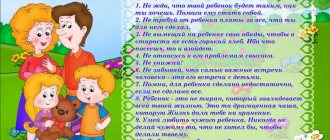Statistics
According to the Russian Ministry of Internal Affairs, in January–July 2016, 8.1 thousand people died in road accidents.
In these road accidents, 254 children died and more than 8,000 children were injured. According to experts, the cause of road accidents is drivers ignoring traffic rules. However, responsibility for road safety also lies with pedestrians, including parents of preschool children. The younger the child, the less sensitive he is to danger; the baby does not always know and understand what exactly threatens him, what consequences this or that behavior may entail. That is why it is very important for mothers, fathers, and other close adults to pay increased attention to the safety of children, and teachers should promptly inform parents about methods and means of preventing accidents. One of the forms of work in this direction is consultation for parents in kindergarten on traffic rules.
The success of speaking to parents of students depends on how the teacher prepares for the consultation, whether he can interest the audience and draw attention to the problem. Preparation of the consultation begins with studying the age characteristics of preschoolers from the point of view of children’s perception of the road and moving vehicles.
How kids see and imagine the roadway
A child’s field of vision is narrower than that of an adult, so it is difficult for a preschooler to determine the distance to a rapidly approaching car. Moreover, the child is not able to calculate the speed of traffic.
Children of early, junior and even middle preschool age do not perceive a car as something potentially dangerous. The kid rushes after the ball that has rolled out onto the road, not thinking at all about moving cars. The main thing for the child is to return the toy. He does not understand that trying to catch the ball may be his last. Therefore, the sooner work begins on children learning the rules of the road, the greater the likelihood of saving children from harm. The teacher tells moms and dads about all this, conducting a consultation on traffic rules for parents.
MSDS
Recently, every school has been required to have a road safety passport. The document includes diagrams of buildings on the school grounds, a plan diagram of the area, where roadways, sidewalks, zebra crossings, etc. are indicated. It also outlines the movement of children on their way to and from the school. Unfortunately, not all schools treat safety data sheets responsibly. Community activists regularly monitor this as part of the “Road to School” campaign. “Often the information in these documents is completely inconsistent with reality. For example, in the diagram posted on the website of a school in Medyn, a road is drawn in the place where the park is located,” says ONF activist in the Kaluga region Vladimir Potapov . – The arrows indicate the movement of children, but on the diagram these arrows are drawn exclusively in front of the school entrance; there are no road signs. This is not the first time we have seen that an electronic road safety passport in schools, unfortunately, turns into an empty document, developed on the principle of “just to be.”
For the safety of the child’s movement on the way from home to school and back, parents need to know how to draw this route on paper as a visual aid. In some educational organizations, this is an official requirement for each student, and the outlined plan is included in the student’s portfolio. The route to school should not necessarily be the shortest, not necessarily the fastest, but certainly the safest for your child.
Question answer
How to properly transport a child in a car?
What and how to tell children about traffic rules
Visual-figurative thinking dominates in preschoolers, so a literal interpretation of the Rules of the Road with a large number of abstract theoretical calculations is unacceptable.
In the second younger group, children are told and shown what a street, sidewalk, or one-way road is. Children are also introduced to types of transport (cars and trucks, buses, trolleybuses, trams), and are told about the work of a driver, traffic lights (red and green signals).
Teachers of the middle group introduce children to two-way traffic on the road, yellow traffic lights, traffic controller gestures, the “Pedestrian Crossing” road sign, ground and underground crossings, classification of modes of transport (water, air, land). They explain how to move along the sidewalk (on the right side) and behave in public transport.
In the senior and preparatory groups, students’ ideas about the road (center line) are expanded. Future schoolchildren are shown road signs (“Crossroads”, “Food station”, “Telephone”, “Medical assistance”, “Parking”, “Pedestrian traffic is prohibited”, “Entry is prohibited”, “Public transport stop”), and the rules are reinforced with the children crossing the roadway.
When working with children it is appropriate to:
- personal example;
- visibility (posters, illustrations);
- reading fiction;
- games.
The teacher informs parents about the content of teaching preschoolers on the topic “Road Rules” in a specific age group, offers handouts (memos, brochures, diagrams), and demonstrates presentations. The teacher talks in detail about how to study at home. The listed methods are appropriate and effective when it comes to consulting parents on traffic rules in kindergarten according to the Federal State Educational Standard.
Personal example
When going somewhere with a child, parents:
- holding the baby's hand;
- while leading the baby along the sidewalk, they themselves are closer to the roadway, and the child walks nearby;
- cross the road when the traffic light is green;
- at the intersection, first they look to the left, then to the right, then to the left again, and only after that, if the cars are far away, they go out onto the roadway and calmly, without fuss, head to the opposite side of the street;
- they don’t cross the road because “it’s closer,” even if they’re in a hurry, they don’t climb over barriers;
- do not catch up with the departing bus, trolleybus, tram or minibus;
- when crossing the road after getting out of the vehicle, the bus, trolleybus and minibus go around from behind, and the tram - from the front;
- do not enter the roadway due to an obstacle (vehicle, bush, fence, etc.);
- in the dark, wear reflective elements (flickers) on yourself and your child;
- They talk through the actions being performed and draw the child’s attention to the need to follow traffic rules.
When transporting a child by car:
- drive a car, observing the rules for drivers;
- children are transported in car seats;
- adults and children get into and out of the car only from the sidewalk.
When disembarking from public transport, an adult leaves first. Rules of behavior on the road are drawn up in the form of a list, table, diagram, which should have a name. For example, consultation on traffic rules for parents “Children’s safety is the concern of adults.”
Visibility
Pictures and posters “Pedestrian Reminder”, “Traffic Light”, “Be Attentive!”, “Road ABC”, etc. help children learn the rules of the road. You can buy a ready-made poster or draw it with your child at home.
Visual materials will not be useful if they hang in the room “in the background.” The teacher draws the attention of parents to the need to talk with the child about the content of the picture, poster, discuss what is depicted, whether the character is doing the right thing, and how to behave in such a situation.
Books on traffic rules for preschoolers
for reading to children of primary preschool age :
- B. Zakhoder “Chauffeur”;
- N. Kalinina “How the guys crossed the street”;
- A. Barto “Truck”, etc.
Children four to five years old are read stories by A. Dorokhov from the book “Green, Yellow, Red”, poems by V. Pishumov “Song about Rules”, S. Mikhalkov “Bad History”, V. Kozhevnikov “Traffic Light”, etc.
Pupils of the senior and preparatory groups get acquainted with the working life of S. Mikhalkov’s hero Uncle Styopa, master the gestures of a traffic controller, listening to V. Dorokhov’s story “The Influential Wand” and V. Semerin’s poem “Forbidden - Permitted”, learn to be exemplary pedestrians and responsible passengers.
An important point when working with parents: do not forget to inform them that after reading a book you should discuss its contents with your child.
Traffic rules games for preschoolers
Play is the leading activity in preschool childhood. The full development of the child, the preschooler’s mastery of vital skills and abilities, takes place precisely in it. Here are some examples of games that a teacher can recommend to parents for studying at home.
Younger preschoolers
The purpose of the didactic game “Traffic Light” is to teach children to recognize traffic light signals. A mock-up of a traffic light with empty holes and two sets of circles in red and green are prepared in advance. The adult gives one set to the child, and keeps the other for himself.
The adult inserts one of the circles into the corresponding hole of the model and invites the child to determine which signal is on (the child picks up a circle of the same color), and also explain what the pedestrian should do (red - stand still, green - look around and walk).
Children from 4 to 5 years old
You can also play “Traffic Light” with kids of this age, just add a yellow signal. No less interesting is “Word Game” . An adult offers to clap your hands when words and phrases related to the following are heard:
- to a traffic light (standing at an intersection, standing at home, red light, blue light, yellow light, brown light, helping a pedestrian, hindering a pedestrian);
- to a pedestrian (intersection, crossing, traffic light, body, standing and waiting, steering wheel, sidewalk);
- to the driver (steering wheel, body, wing, rides, motor, flies, wheel, paws, tail);
- to the passenger (bus, trolleybus, pulls up to a stop, bed, stool, stop, shows a ticket).
Senior preschool age
The game “Guess the Sign” will help you consolidate the names and purposes of road signs . An adult places cardboard signs in plain sight and offers to guess the sign based on the description (in random order he talks about the purpose of the signs).
During the consultation, the teacher invites parents to play and takes on the role of facilitator.
By personal example
The first thing that parents, who are the main teachers of children in safe behavior on the road, need to remember is that children do not so much perceive words as they perceive examples. You can constantly tell them that you can’t cross a red light, but once a mother and her child cross the road like that, all the traffic rules lessons will go down the drain. Yes, schools and even kindergartens now devote time to teaching norms of behavior on the streets, but it is not enough. Often such classes are carried out for show. Of course, a 10-year-old boy understands that you can’t cross the road when it’s red, but many of his classmates no longer know how and where to ride a scooter or bicycle correctly.
Young Traffic Inspectors (JIT) have a huge influence on their peers. Members of the JID teams not only learn traffic rules themselves, but also help their peers learn the rules, and often remind adults of the need to comply with them.
“The role of parents is primary. After all, even when we come to kindergarten with educational programs, we see how the child is involved in the process, how he does not want to break the traffic rules and how he knows all the points of behavior on the road. But as soon as a child sees that his parents are calmly breaking the rules and are not hit by a car, he involuntarily begins to do it himself. The entire training system immediately breaks down,” says the head of the YID detachment, Tatiana Okan . – The YID teams are created, in fact, to help organize the prevention of child injuries due to road accidents in schools with the help of the children themselves. We organize various events for both schoolchildren and parents. Children essentially teach each other through play. And I can say that we noticed that in schools where the JID units operate, over a long period of time the number of road accidents involving schoolchildren has come to naught.”
Security laboratory. How to teach modern children traffic rules Read more
By the way
- In Syktyvkar, the State Traffic Inspectorate and the Judicial Inspectorate conduct a “Safety Hour” on traffic rules in clinics for young patients and their parents. Children were reminded why it is important to wear reflectors. Yuida members prepared traffic rules tests for parents. All those who answered correctly were awarded memorable prizes.
- In Transbaikalia, Parent Patrol conducts master classes on traffic rules at playgrounds. Parents, together with traffic inspectors, are on duty in the courtyards, near schools and kindergartens. They tell children and adults about how to cross the road correctly, how to behave when boarding route vehicles, and in which places it is allowed to ride bicycles and roller skates.
- In the Tula region, they decided to unobtrusively make pedestrians more visible at night. The State Traffic Inspectorate presented plastic bags with the image of a samovar and the inscription: “Tula, light up,” which were made with reflective paint. Regional authorities supported the idea of traffic inspectors - such bags will be distributed among the population and packaged in them for purchases in stores in the region.




